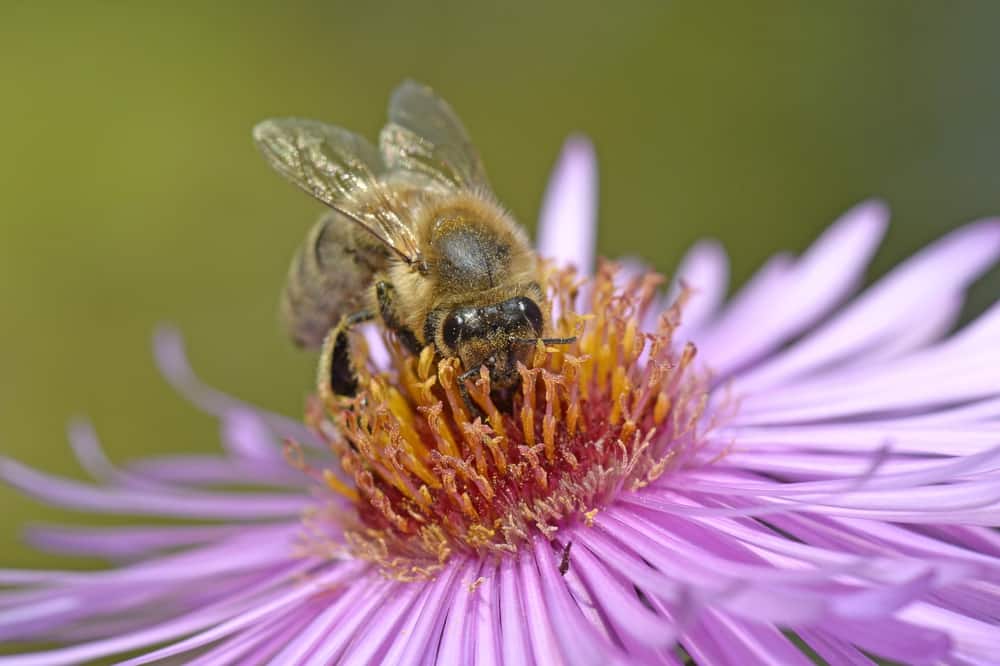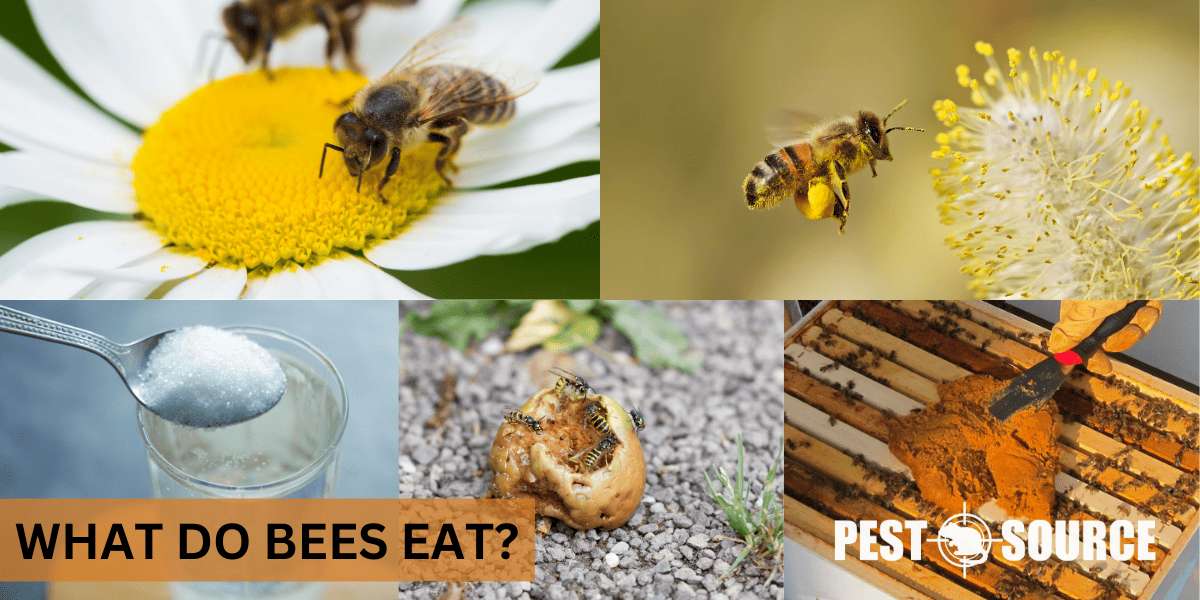Bees primarily eat nectar and pollen from flowers. Nectar provides them with carbohydrates for energy, while pollen offers proteins and fats necessary for their diet. This diet supports their high-energy needs for foraging, maintaining the hive, and caring for their young. The relationship between bees and flowers is a remarkable example of nature’s interconnectedness, showcasing the critical role bees play in pollination and the health of ecosystems. Explore how bees’ dietary preferences impact their behavior and the environment.
POINTS
- Bees primarily consume nectar and pollen, which provide the essential carbohydrates and proteins needed for their survival and the health of their colonies.
- Honey bees collect and convert nectar into honey, which is used as a food reserve for the colony, particularly during times when resources are scarce.
- Bees have anatomical adaptations such as a proboscis and mandibles that facilitate efficient feeding on nectar and pollen, and their nutritional needs vary across different species.
- Seasonal changes, environmental factors, and human activities like agriculture and pesticide use significantly influence bee diets and can impact bee populations and ecosystem health.
- Attracting bees with food through planting diverse, flowering plants and providing clean water sources is beneficial, but reliance on artificial feeding should be managed to ensure bees’ health and natural foraging behaviors are maintained.
General Diet and Primary Food Sources of Bees
Bees, known for their vital role in pollination, have specific dietary needs that are fascinating to explore. The fundamental diet of bees centers around two primary food sources: nectar and pollen. These substances not only provide energy but also the essential nutrients required for their survival and the health of their colonies.
Diversity in Bee Diets
While nectar and pollen are the mainstays of a bee’s diet, there is a significant diversity in what different bee species consume. Honey bees, for instance, are particularly attracted to flowers from which they can harvest nectar and pollen. However, other bee species may have more specialized diets. Some are pollen specialists (oligolectic), collecting pollen from a narrow group of plant species, while others are generalists (polylectic), gathering pollen from a wide variety of plants.
Alternative Food Sources for Bees
Occasionally, bees may resort to less common or alternative food sources. This can include overripe fruits, where they extract the sugary juices. Human-provided foods, such as sugar water or beekeeper-provided pollen substitutes, can also play a role in a bee’s diet, especially when natural sources are scarce.

Nectar, Pollen, and Honey: The Staples of a Bee’s Diet
Importance and Role of Nectar, Pollen, and Honey
Nectar and pollen are not just food for bees; they are the building blocks of the hive’s future. Nectar, a sugary liquid produced by flowers, is the primary source of carbohydrates for bees, providing them with the energy necessary for their rigorous workloads.

Pollen, on the other hand, is a protein-rich substance that also contains fats, vitamins, and minerals, contributing to the overall nutritional needs of the hive.

How Bees Collect and Convert These Substances
Bees have evolved an efficient system to collect, consume, and convert nectar and pollen into energy and food stores. They use their long, tube-like tongues called proboscises to suck up nectar and store it in their “honey stomachs.” Back at the hive, the nectar is regurgitated and processed by worker bees to create honey. Pollen is collected using the hairs on their bodies and is packed into pellets on their hind legs to be transported back to the hive.
Production and Consumption of Honey
Bees produce honey as a way of storing food for times when resources are scarce, such as during the winter. There’s a common misconception that bees consume the honey they produce. While they do eat honey, it is primarily used as a food reserve for the colony. The bees that do consume honey are typically worker bees who need the energy for their foraging activities and to maintain the hive’s temperature by beating their wings.
Feeding Mechanics and Nutritional Needs of Bees
Mechanics of How Bees Eat
The anatomy of a bee is uniquely adapted for feeding on nectar and collecting pollen. Their proboscis works like a straw, allowing them to access nectar deep within flowers. Their mandibles help them manipulate pollen and wax to construct their hives and care for their young.
Nutritional Requirements of Bees
The nutritional needs of bees are complex and must be met to ensure the health of the individual and the colony. Protein from pollen is crucial for the development of larvae and the production of royal jelly by nurse bees. Carbohydrates from nectar provide the energy necessary for foraging, regulating hive temperature, and performing other tasks within the colony.
Dietary Differences Among Bee Species
Different bee species have varying dietary preferences and requirements. While honey bees are generalists in their pollen and nectar collection, other species may have a more specialized diet. For example, the bumblebee has a longer proboscis than the honey bee, allowing it to access nectar from flowers with deeper corolla tubes.
Environmental Influences on Bee Diets and Human Impact
Seasonal Changes and Bee Diets
Bees’ diets are profoundly influenced by their environment, particularly by seasonal changes. During spring and summer, a plethora of flowers bloom, providing bees with abundant sources of nectar and pollen. However, during autumn and winter, these resources dwindle, and bees rely heavily on their stored honey and pollen to survive. This cyclical pattern dictates the foraging behavior and dietary intake of bees throughout the year.
Adaptations to Changes in Food Availability
Bees have developed remarkable adaptations to cope with fluctuations in food availability. For example, during times of plenty, they engage in a frenetic period of foraging and storing, known as “making hay while the sun shines.” Conversely, in the colder months, bees cluster together for warmth, reducing their metabolic rate to conserve energy and extend their food supplies.
Human Activities Affecting Bee Populations
Human activities, such as agriculture, urban development, and pesticide use, have significant implications for bee populations and the availability of their natural food sources. Habitat destruction reduces the number of flowering plants, while pesticides can contaminate the pollen and nectar bees collect, leading to colony health issues or even colony collapse disorder. It’s crucial for humans to understand and mitigate these impacts to ensure the sustainability of bee populations and, by extension, the ecosystems they support.
Attracting Bees with Food: Effective Practices and Impact
Attracting Bees Responsibly
To attract bees and support their dietary needs, individuals can plant a variety of nectar and pollen-rich flowers that bloom at different times of the year, creating a consistent food source. Providing clean water sources and avoiding pesticides also contribute to a healthy environment for bees. When natural food sources are insufficient, especially in urban settings, beekeepers may provide sugar water or commercially available pollen substitutes.
Impact of Artificial Feeding on Bees
While supplemental feeding can be beneficial, especially in times of scarcity, it’s essential to consider the impact on bees’ health and behavior. Artificial feeding should mimic the nutritional composition of natural food sources as closely as possible to prevent dietary deficiencies. Over-reliance on supplemental feeding can also discourage bees from foraging and lead to a decrease in pollination, affecting plant biodiversity.
What Eats Bees?
Predators of bees include birds like bee-eaters, amphibians such as frogs, and insects like dragonflies, praying mantises, and wasps. Certain mammals like bears and badgers also eats bees, mainly for their larvae and honey. Additionally, arachnids such as spiders can prey on bees, ensnaring them in webs. Parasites like the Varroa destructor mite can weaken bees, making them more susceptible to predators.



